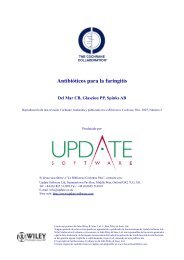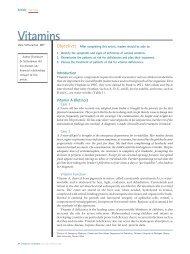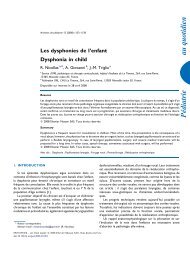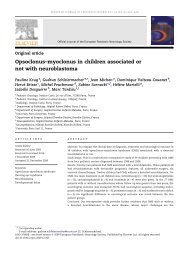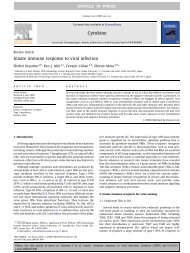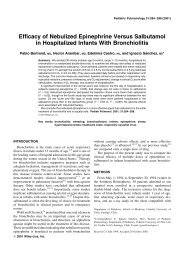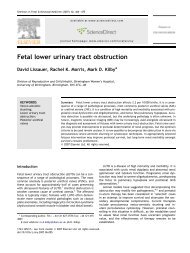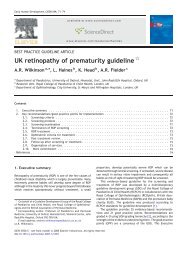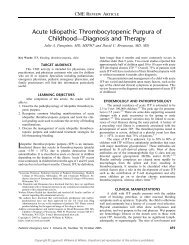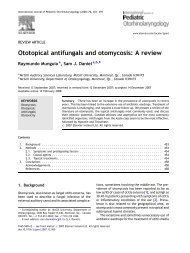Long term prognosis of symptomatic occipital lobe epilepsy ... - sepeap
Long term prognosis of symptomatic occipital lobe epilepsy ... - sepeap
Long term prognosis of symptomatic occipital lobe epilepsy ... - sepeap
You also want an ePaper? Increase the reach of your titles
YUMPU automatically turns print PDFs into web optimized ePapers that Google loves.
<strong>Long</strong>itudinal clinical course 99<br />
The posterior cerebral predilection <strong>of</strong> neonatal hypoglycemic<br />
encephalopathy has been demonstrated by<br />
computed tomography and magnetic resonance imaging<br />
(Chiu, 1998; Traill et al., 1998; Kinnala et al., 1999). The<br />
possible reasons for the pattern <strong>of</strong> damage may relate to the<br />
high degree <strong>of</strong> axonal migration and synaptogenesis occurring<br />
within the <strong>occipital</strong> <strong>lobe</strong> during the neonatal period and<br />
the development <strong>of</strong> receptors for excitatory amino acids<br />
which can be stimulated by elevated levels <strong>of</strong> aspartate.<br />
This last mechanism could result in the selective death <strong>of</strong><br />
the postsynaptic neurons. It has also been hypothesized that<br />
high metabolic turnover during early life predisposes this<br />
area to injury as occurs in mitochondrial diseases (Dvorkin<br />
et al., 1987).<br />
A few limitations <strong>of</strong> this study can now be examined.<br />
First, the small number <strong>of</strong> patients may affect the accuracy<br />
<strong>of</strong> the results. Further studies with larger numbers<br />
are needed. Second, <strong>occipital</strong> <strong>lobe</strong> <strong>epilepsy</strong> was based on<br />
seizure semiology and interictal EEG. The possibility <strong>of</strong><br />
frontal or temporal <strong>lobe</strong> <strong>epilepsy</strong> cannot be completely<br />
denied in patients with extra-<strong>occipital</strong> <strong>lobe</strong> abnormality.<br />
Third, <strong>occipital</strong> <strong>lobe</strong> injuries could not be identified on MRI<br />
in 2 patients. Brain injuries could be subtle, while nevertheless<br />
we cannot deny the possibility <strong>of</strong> minor focal cortical<br />
dysplasia.<br />
In <strong>occipital</strong> <strong>lobe</strong> <strong>epilepsy</strong> in infancy and early childhood,<br />
neonatal hypoglycemia should be considered as an important<br />
possible etiology. Seizures are liable to be pharmacoresistant<br />
and develop status epileptics in infancy and early<br />
childhood, while they mostly decrease and are shortened in<br />
late childhood and adolescence.<br />
References<br />
Alkalay, A.l., Flares-Sarnat, L., Sarnat, H.B., Moser, F.G., Simmons,<br />
C.F., 2005. Brain imaging findincs in neonatal hypoglycemia: case<br />
report and review <strong>of</strong> 23 cases. Clin. Pediatr. (Phila) 44, 783—<br />
790.<br />
Caraballo, R.H., Sakr, D., Mozzi, M., Guerrero, A., Adi, J.N., Cersósimo,<br />
R.O., Fejerman, N., 2004. Symptomatic <strong>occipital</strong> <strong>lobe</strong><br />
<strong>epilepsy</strong> following neonatal hypoglycemia. Pediatr. Neurol. 31,<br />
24—29.<br />
Chiu, N.T., 1998. Technetium-99m-HMPAO brain SPECT in<br />
neonates with hypoglycemic encephalopathy. J. Nucl. Med. 39,<br />
1711—1713.<br />
Dvorkin, G.S., Andermann, F., Carpenter, S., Melanson, S., Verret,<br />
S., Jacob, C., Sherwin, A., Bekhor, S., Lugaresi, E., Sackellares,<br />
C., Willoughby, J., MacGregor, D., 1987. Classical migraine,<br />
intractable <strong>epilepsy</strong> and multiple strokes: a syndrome related to<br />
mitochondrial encephalomyopathy. In: Andermann, F., Lugaresi,<br />
E. (Eds.), Migraine and Epilepsy. Butterworths, London, pp.<br />
203—232.<br />
Filan, P.M., Inder, T.E., Cameron, F.J., Kean, M.J., Hunt, R.W., 2006.<br />
Neonatal hypoglycemia and <strong>occipital</strong> cerebral injury. J. Pediatr.<br />
148, 552—555.<br />
Gil-Nagel, A., García Morales, I., Jiménez Huete, A., Alvarez Linera,<br />
J., del Barrio, A., Ruiz Ocaña, C., Muñoz, D.G., 2005. Occipital<br />
<strong>lobe</strong> <strong>epilepsy</strong> secondary to ulegyria. J. Neurol. 252, 1178—1185.<br />
Kinnala, A., Rikalainen, H., Lapinleimu, H., Parkkola, R., Kormano,<br />
M., Kero, P., 1999. Cerebral magnetic resonance imaging<br />
and ultrasonography findings after neonatal hypoglycemia. Pediatrics<br />
103, 724—729.<br />
Montassir, H., Maegaki, Y., Ogura, K., Kurozawa, Y., Nagata, I.,<br />
Kanzaki, S., Ohno, K., 2009. Associated factors in neonatal hypoglycemic<br />
brain injury. Brain Dev. 31, 649—656.<br />
Murakmi, Y., Yamashita, Y., Matsuishi, T., Utsunomiya, T., Okudera,<br />
T., Hashimoto, T., 1999. Cranial MRI <strong>of</strong> neurologically impaired<br />
children suffering from neonatal hypoglycemia. Pediatr. Radiol.<br />
29, 23—27.<br />
Norden, A.D., 2001. A novel <strong>epilepsy</strong> syndrome secondary to neonatal<br />
hypoglycemia. Epilepsia 42 (Suppl. 7), S50.<br />
Oguni, H., Sugama, M., Osawa, M., 2008. Symptomatic parieto<strong>occipital</strong><br />
<strong>epilepsy</strong> as sequel <strong>of</strong> perinatal asphyxia. Pediatr.<br />
Neurol. 38, 345—352.<br />
Okanishi, T., Maegaki, Y., Ohno, K., Togari, H., 2008. Underlying<br />
neurologic disorders and recurrence rates <strong>of</strong> status epilepticus<br />
in childhood. Brain Dev. 30, 624—628.<br />
Pisani, F., Orsini, M., Braibanti, S., Copioli, C., Sisti, L., Turco,<br />
E.C., 2009. Development <strong>of</strong> <strong>epilepsy</strong> in newborn with moderate<br />
hypoxic-ischemic encephalopathy and neonatal seizures. Brain<br />
Dev. 31, 64—68.<br />
Srinivasan, G., Pildes, R.S., Cattamanchi, G., Voora, S., Lilien, L.D.,<br />
1986. Plasma glucose values in normal neonates: a new look. J.<br />
Pediatr. 109, 114—117.<br />
Traill, Z., Squier, M., Anslow, P., 1998. Brain imaging in neonatal<br />
hypoglycemia. Arch. Dis. Child. Fetal Neonatal Ed. 79,<br />
F145—F147.<br />
Villani, F., D’Incerti, L., Granata, T., Battaglia, G., Vitali, P., Chiapparini,<br />
L., Avanzini, G., 2003. Epileptic and imaging findings<br />
in perinatal hypoxic-ischemic encephalopathy with ulegyria.<br />
Epilepsy Res. 55, 235—243.<br />
Williamson, P.D., Thadani, V.M., Darcey, T.M., Spencer, D.D.,<br />
Spencer, S.S., Mattson, R.H., 1992. Occipital <strong>lobe</strong> <strong>epilepsy</strong>:<br />
clinical characteristics, seizure spread patterns, and results <strong>of</strong><br />
surgery. Ann. Neurol. 31, 3—13.<br />
Yalnizoglu, D., Halioglu, G., 2007. Neurological outcome in patients<br />
with MRI pattern <strong>of</strong> damage typical for neonatl hypoglycemia.<br />
Brain Dev. 29, 285—292.<br />
Zafeiriou, D.I., Kontopoulos, E.E., Tsikoulas, I., 1999. Characteristics<br />
and <strong>prognosis</strong> <strong>of</strong> <strong>epilepsy</strong> in children with cerebral palsy. J.<br />
Child Neurol. 14, 289—294.




